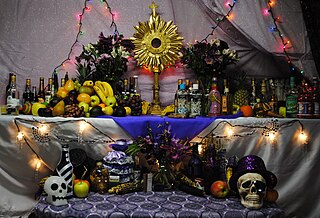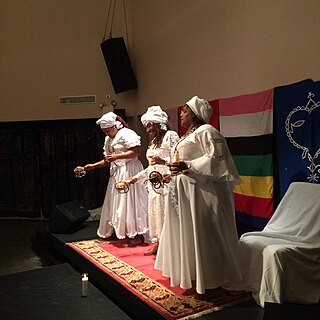
Loa are the spirits of Haitian Vodou and Louisiana Voodoo. They are also referred to as "mystères" and "the invisibles" and are intermediaries between Bondye — the Supreme Creator, who is distant from the world — and humanity. Unlike saints or angels, however, they are not simply prayed to, they are served. They are each distinct beings with their own personal likes and dislikes, distinct sacred rhythms, songs, dances, ritual symbols, and special modes of service. Contrary to popular belief, the loa are not deities in and of themselves; they are intermediaries for, and dependent on, a distant Bondye.

Damballa, also spelled Damballah, Dambala, Dambalah, among other variations, is one of the most important of all loa, spirits in Haitian Vodou and Louisiana Voodoo traditions. He is portrayed as a great white serpent, originating in the city of Wedo in modern-day Benin. Damballa is said to be the Sky Father and the primordial creator of all life, or the first thing created by Gran Met. In those Vodou societies that view Damballa as the primordial creator, he created the cosmos by using his 7,000 coils to form the stars and the planets in the heavens and to shape the hills and valleys on earth. In others, being the first thing created by God, creation was undertaken through him. By shedding the serpent skin, Damballa created all the waters on the earth. As a serpent, he moves between land and water, generating life, and through the earth, uniting the land with the waters below. Damballa is usually syncretized with either Saint Patrick or Moses. He is counted among the Rada loa.

Baron Samedi, also written Baron Samdi, Bawon Samedi or Bawon Sanmdi, is one of the loa of Haitian Vodou. Samedi is a loa of the dead, along with Baron's numerous other incarnations Baron Cimetière, Baron La Croix and Baron Kriminel. He is syncretized with Saint Martin de Porres.
Baron Cimitière is one of the Guédé, a spirit of the dead, along with Baron Samedi and Baron La Croix in Vodou. He is said to be the guardian of the cemetery, protecting its graves.
Baron La Croix, or Bawon Lakwa in Haitian Creole, is one of the Guédé, a loa of the dead and sexuality, along with Baron Samedi and Baron Cimetière in Vodou. He is syncretized with Saint Expeditus.
In Haiti, the Guédé are the family of loa that embody the powers of death and fertility. Guédé spirits include Ghede Doubye, Ghede Linto, Ghede Loraj, Guédé Nibo and Guédé Ti Malis. All are known for the drum rhythm and dance called the "banda". In possession, they will drink or rub themselves with a mixture of clairin and twenty-one Scotch bonnet or goat peppers. Fête Ghede is celebrated on 2 November, All Souls' Day. Boons granted by the Ghede not repaid by this date will be avenged afterwards.

Papa Legba is a loa in Haitian Vodou, who serves as the intermediary between the loa and humanity. He stands at a spiritual crossroads and gives permission to speak with the spirits of Guinee, and is believed to speak all human languages. In Haiti, he is the great elocutioner. Legba facilitates communication, speech, and understanding. He is commonly associated with dogs.

Maman Brigitte also written Gran Brigitte, Grann Brigitte, Manman, Manman Brigit, and Maman Brijit, is a death loa and the consort of Baron Samedi in Haitian Vodou. She drinks rum infused with hot peppers and is symbolized by a black rooster. Like Samedi and the Ghede, she is foul-mouthed. She is also the adoptive mother of Ghede Nibo.
In the religion of Haitian Vodou, Captain Debas is a loa of the ghede.

Erzulie is a family of loa, or spirits, in Vodou.
Haitian Vodou is a syncretic mixture of Roman Catholic rituals developed during the French colonial period, based on traditional African beliefs, with roots in Dahomey, Kongo and Yoruba traditions, and folkloric influence from the indigenous Taino peoples of Haiti. The Loa, or spirits with whom Vodouisants work and practice, are not gods but servants of the Supreme Creator Bondye. In keeping with the French-Catholic influence of the faith, vodousaints are for the most part monotheists, believing that the Loa are great and powerful forces in the world with whom humans interact and vice versa, resulting in a symbiotic relationship intended to bring both humans and the Loa back to Bondye. "Vodou is a religious practice, a faith that points toward an intimate knowledge of God, and offers its practitioners a means to come into communion with the Divine, through an ever evolving paradigm of dance, song and prayers."

A veve is a religious symbol commonly used in different branches of Vodun throughout the African diaspora such as Haitian Vodou. Veves should not be confused with the patipembas used in Palo, nor the pontos riscados used in Umbanda and Quimbanda since these are separate African religions. The veve acts as a "beacon" for the Loa, and will serve as a loa's representation during rituals.

Houngan or oungan is the term for a male priest in Haitian Vodou. The term is derived from the Fon word hounnongan. Houngans are also known as makandals.

Homosexuality in Haitian Vodou is religiously acceptable and homosexuals are allowed to participate in all religious activities. However, in countries with large Vodou populations, some Christian influence may have given homosexuality a social stigma, at least on some levels of society.
A bokor (male) or caplata (female) is a Vodou witch for hire who is said to serve the loa "with both hands", practicing for both good and evil. Their black magic includes the creation of zombies and the creation of 'ouangas', talismans that house spirits.

A mambo is a priestess in the Haitian Vodou religion. Haitian Vodou's conceptions of priesthood stem from the religious traditions of enslaved people from Dahomey, in what is today Benin. For instance, the term mambo derives from the Fon word nanbo. Like its West African counterpart, Haitian mambos are female leaders in Vodou temples who perform healing work and guide others during complex rituals. This form of female leadership is prevalent in urban centers such as Port-au-Prince. Typically, there is no hierarchy among mambos and houngans. These priestesses and priests serve as the heads of autonomous religious groups and exert their authority over the devotees or spiritual servants in their hounfo (temples). Mambos and houngans are called into power via spirit possession or the revelations in a dream. They become qualified after completing several initiation rituals and technical training exercises where they learn the Vodou spirits by their names, attributes, and symbols. The first step in initiation is lave tèt, which is aimed at the spirits housed in an individual's head. The second step is known as kouche, which is when the initiate enters a period of seclusion. Typically, the final step is the possession of the ason, which enables the mambo or houngan to begin their work. One of the main goals of Vodou initiation ceremonies is to strengthen the mambo's konesans—knowledge that determines priestly power.
Vodou drumming and associated ceremonies are folk ritual faith system of henotheistic religion of Haitian Vodou originated and inextricable part of Haitian culture.
Ghede Nibo is a loa who is leader of the spirits of the dead in Haitian Vodou. Formerly human, Ghede Nibo was a handsome young man who was killed violently. After death, he was adopted as a loa by Baron Samedi and Maman Brigitte. He is envisioned as an effeminate, nasal dandy. Nibo wears a black riding coat or drag. When he inhabits humans they are inspired to lascivious sexuality of all kinds.
Various LGBT themes are present in different in African diasporic mythologies, primary among them being Voodoo.

Dominican Vudú, also known as Las 21 Divisiones, is a syncretic religion of Caribbean origin which developed on the island of Hispaniola.









